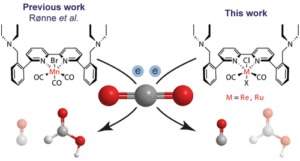Monica R Madsen, Joakim B Jakobsen, Magnus H Rønne, Hongqing Liang, Hans Christian D Hammershøj, Peter Nørby, Steen U Pedersen, Troels Skrydstrup, Kim Daasbjerg
https://doi.org/10.1021/acs.organomet.9b00815
Carbon dioxide utilization through electrocatalysis is a promising pathway toward a more sustainable future. In this work the electrocatalytic reduction of carbon dioxide by ReI and RuIIbipyridine complexes bearing pendant amines (N,N′-(([2,2′-bipyridine]-6,6′-diylbis(2,1-phenylene))bis(methylene))bis(N-ethylethanamine) (dEAbpy)) is evaluated. In both cases, the major reduction product is carbon monoxide accompanied by some formic acid, although the yield of the latter never reaches the predominant level known from the corresponding Mn(dEAbpy)(CO)3Br complex. This demonstrates the profound effect of the identity of the metal center, in addition to the ligand, for the product distribution. In this work, we report the synthesis procedures and X-ray diffraction studies along with electrochemical and infrared spectroelectrochemical studies of Re(dEAbpy)(CO)3Cl and Ru(dEAbpy)(CO)2Cl2 to propose a mechanism for the CO2 reduction reaction.
